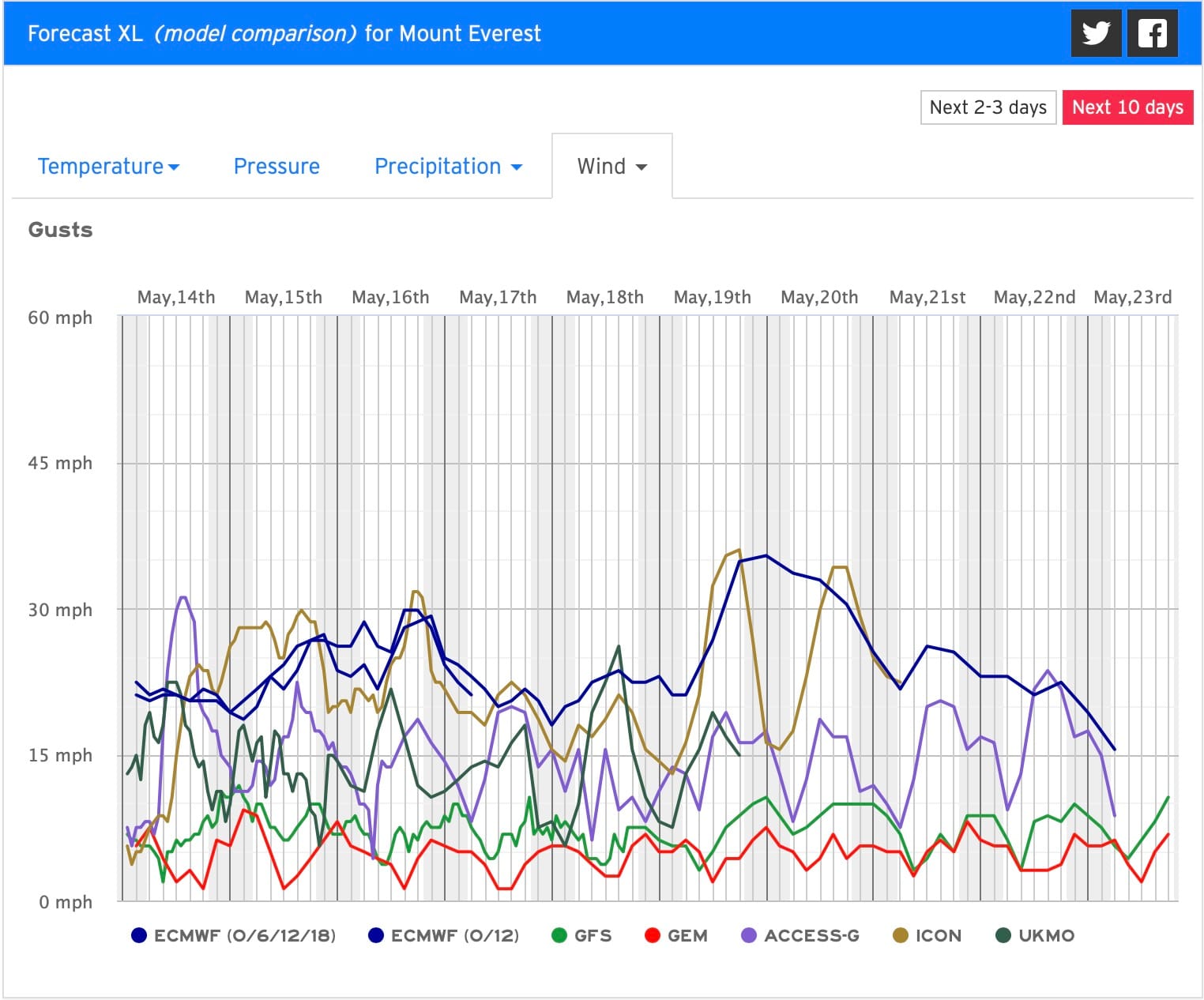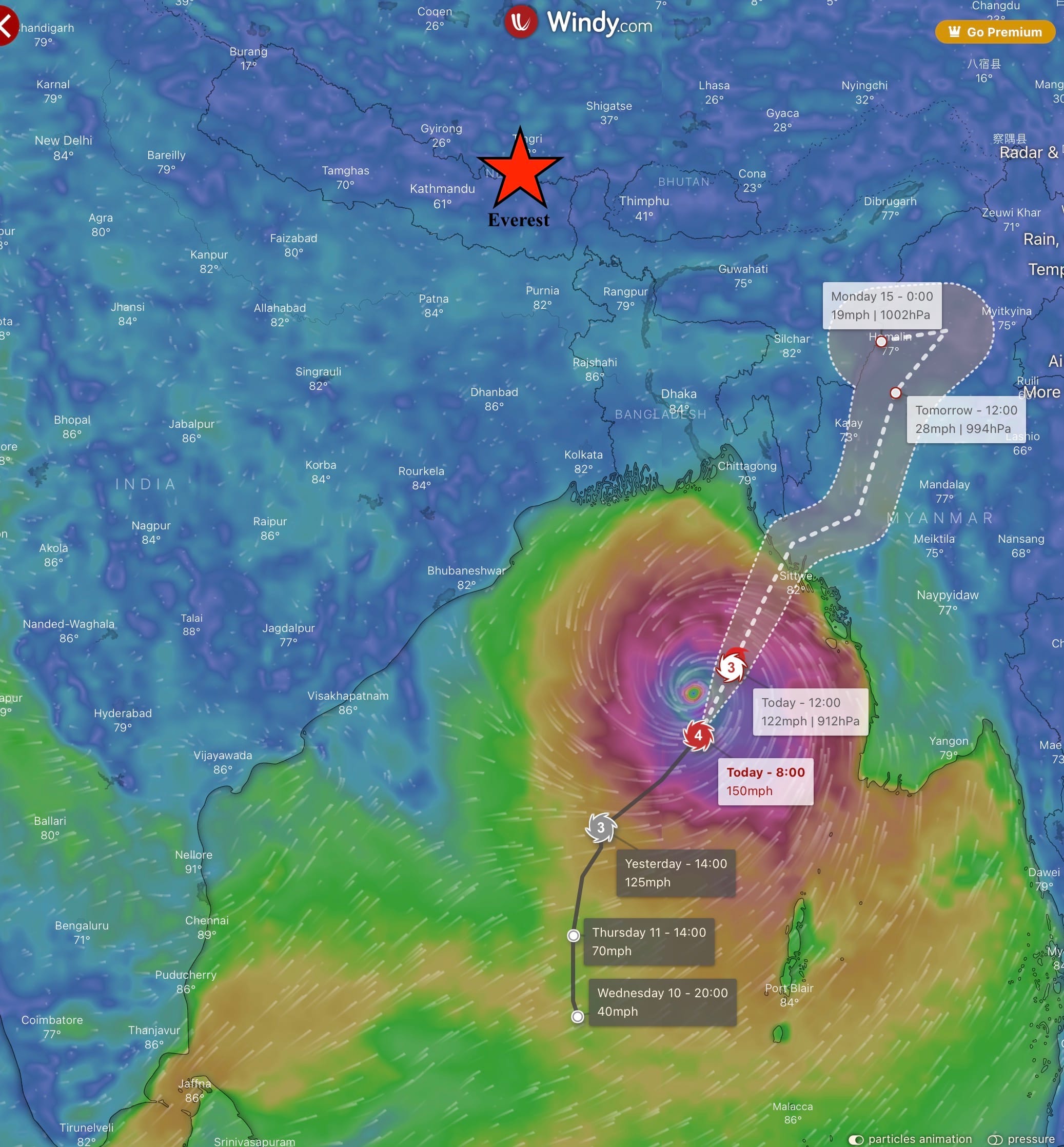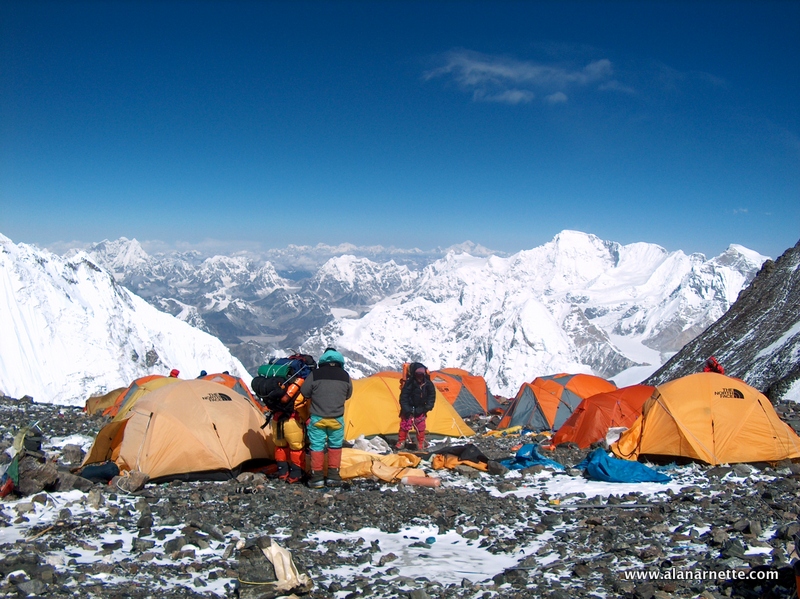With the ropes now fixed to the summit, hundreds of people left Everest Base Camp over the past several days for their summit push. The winds appear to be under the 30 mph threshold through May 20, hopefully allowing climbers to spread out and avoid the massive queues of 2019. Many teams are eyeing Wednesday, May 17th as their summit day. Meanwhile, thieves appear to be at work on Everest, rare but not uncommon.
Everest Summit Swarm
Weather


Summit Schedule
- EBC- C2: 6 hours (note: some teams will stop at C1, and go to 2 the next day)
- C2-C3: 6 hours – sleep at C3 using supplemental oxygen (note: some teams start Os at C2)
- C3-C4 (South Col): 4 hours – leave SC around 8 pm the same day (note: some teams will spend a full night at the South Col)
- C4-Summit: 8-12 hours- stay on the summit for 15 to 60 minutes
- Summit-C4: 3-5 hours – quick 30-minute rest and drink water
- C4-C2: 2-4 hours – sleep at C2
- C2- EBC – 2-4 hours – celebrate!
Theft – rare but not uncommon
Occasionally, a team will report that something goes missing from their camp or tent. This can be an honest mistake or a premeditated act by a climber or team, who chooses not to provision properly for an Everest climb or, in their strange world, feels that everyone’s property s also theirs for the taking. Adventure Consultants MD, Guy Cotter, reported that his team was a recent victim
We just discovered we’ve had a cache of gear stolen from South Col. Tents, stoves, pots and gas all gone. The thieves do not consider the impacts this might have on the safety of our people when they arrive to find this vital equipment gone. This is the work of cheap operators who do not have enough of their own equipment and have to steal to cover the shortfall. I think this may only be the start, we already hear of some of the large cheap. Operators not having enough oxygen to supply this teams. Anyone joining a cheap operator is as much to blame as the thieves themselves.
In 2017, a similar event occurred, as reported by Tim Mosedale, at their high camp on Lhotse. Tim posted then:
Some low life scumbag has taken the stash of oxygen from the tent at Lhotse Camp 4. Ronnie and Pemba have just arrived and were hoping to be poised for their summit bid for tomorrow. It’s soooo obviously our tent (markings on the outside, gear inside) so there’s no excuse or chance for confusion.
Yes, if there’s an emergency, then we’ll help. As long as we know that our oxygen is being used we can get it resupplied (or the team needing it can replace it). But to turn up and take it causes not only an issue for the summit team but also jeopardises the lives of other climbers.
It’s completely unacceptable.
Thankfully we’ve got another stash close by so Pemba has gone down to get that but that’s going to waste an hour of his time and energy. I’d never normally wish ill on anyone but if these thieving bastards don’t summit, or get frostbite in the process, then that’s karma.
If you wonder how some teams can offer an Everest climb at half or more than their competition, one way to cut corners is by paying their staff low wages or not fully stocking their camps and stealing from others. When gear goes missing, often it’s at the South Col when there are few people around. It takes a lot of manpower to get tents and oxygen bottles to the South Col, so an unscrupulous operator can save tens of thousands of dollars by pilfering other’s stocks. A few weeks ago, the Nepali government crowed about putting officials on the mountain this year to maintain order …
Pre- Acclimatizing or Fuzzy math?
Using altitude tents has come into fashion for Everest climbers. The theory is that by sleeping in a pressurized plastic tent for weeks before going to altitude, your body will be acclimatized to an altitude as high as 7,000 meters/23,000 feet. Companies like Furtenbach Adventures and Alpenglow swear by this approach and makes it a crucial part of the fast climbs, for example, Everest in three weeks instead of six or eight.
Well, the fine folks at EverestEr are pouring some cold water on this thin air. They, of course, run the all-volunteer medical clinic at Everest Base Camp on the Nepal side and treat scores of individuals with all sorts of health issues, including many related to altitude sickness. They posted that they have their doubts:
We’ve seen a few folks who are cutting their trips short by attempting reacclimatization at home in a hypoxic tent. These tents can simulate thin air, but not the low pressure environment that just may be a crucial factor for acclimatization. The marketing pitch goes something like this: stay home, stay at work, just sleep in a hypoxia tent at night, fly right in to base camp and start your climb, skipping that 2 week acclimatization walk.
NOT SO FAST! The Wilderness Medical Society altitude guidelines, written by a panel of experts that scour the literature, have this to say: Although the systems are marketed to be of benefit and anecdotal reports suggest they are widely used by climbers and other athletes competing at high altitude, there are no data indicating increased likelihood of summit success or improved physical performance. Any benefit that may accrue from these systems is more likely with long hypoxic exposures (>8 h per day) for at least several weeks before planned high altitude travel. In addition to the cost of the systems and power needed to run them, individuals face the risk of poor sleep, which over a long period of time could have deleterious effects on performance during an expedition. (Paraphrasing, for more information, visit this free download for the full discussion: https://www.wemjournal.org/…/S1080-6032(19…/fulltext
So do they work? There are many variables that could play into their success or failure. One is an incomplete understanding about the role of pressure in the acclimatization equation, another is that different tents may have different standards/construction, another is the protocol for use (eg what role do individual genetics play? how long should they be used in advance? how many breaks can a person take?) The bottom line is that much more research needs to be done if these devices are to be relied upon. In the meantime, the safest approach is the old fashioned one: time and gradual ascent.
Other 8000ers
Norweigan, Kristin Harila, who is collecting 8000ers this year, got her third tippy top. She got the summits of Cho Oyu and Shishapangma in the last couple of weeks, and now she summited Makalu, 8,485 meters, along with Tenjen Lama Sherpa and Lakpa Sherpa. Also summiting was the rope team of Ang Dawa Sherpa, Chhiring Namgyal Sherpa, Dorchi Sherpa, Angdemba Sherpa, Pema Sherpa, and Furtemba Sherpa. Imagine Nepal noted that Swedish climber Raul Erik Helander and Pemba Chhiri Sherpa, and Ngima Nuru Sherpa made the summit. There are 58 foreigners with permits for Makalu this season.
There are teams ready for the summit on Kangchenjunga. There were summits on Cho Oyu from the Tibet side by Viridiana Alvarez supported by Ngima Rita and Pemba Tenjin Sherpa. Over on, Dhaulagiri, Carlos Soria, Sito Carcavilla and their Sherpa team have cached gear at Camp 1 and are holding for better conditions after horrendously heavy snowfall the past few weeks. Busy time in Nepal.
Denali
Not to be left out, it’s climbing season on North America’s highest, Alaska’s Denali, at 20,310 feet/6,190 meters. The season was declared officially open on April 27, 2023, with Park Rangers flying to their base camp at 14,000 feet. They will stay there and conduct patrols the entire season, something I wish Nepal officials would copy, stationing qualified and empowered rangers at Camp 2.
According to the National Park Service, 903 climbers have already registered, but only 83 are on the peak, and only one summited, soloist Jost Kobusch, back on February 19, 2023.
Meanwhile, the search continues for signs of two missing climbers on the Moose’s Tooth, a 10,300-foot peak near the Ruth Gorge in Denali National Park and Preserve. The NPS reports, “Based on boot prints and other clues, 34-year-old Eli Michel and 32-year-old Nafiun Awal, likely fell while climbing high on the West Ridge route of the Moose’s Tooth on Friday, May 5.”
My condolences to their families and friends.
Best of luck to all for a positive experience.
Climb On!
Alan
Memories are Everything
Nepal RECORD Permit Update as of May 7, 2023
The permits for Everest are leveling out, albeit at a record of 467. The previous Everest record was 408 for the 2021 season of 408. Nepal issued climbing permits for 1,123 climbers from 80 countries for 27 peaks. Looking at Everest only, China has the largest representation with 96 members, followed by the US at 87, India–at 40, Canada-21, and Russia-20. There are 44 countries represented by three or fewer climbers.
These permits have generated $5.6M in royalties for the government. Almost all of this revenue stays in Kathmandu, with some in various personal pockets and none to the Sherpas, porters, or other high-altitude workers. The Nepal Ministry of Tourism posted these foreign permit tallies as of April 28, 2022:
- Everest: 467 on 44 teams
- Lhotse: 126 on 14 teams
- Ama Dablam: 79 on 8 teams
- Nuptse: 63 on 6 teams (only a few will attempt to summit, most will stop at C2)
- Makalu: 58 on 7 teams
- Annapurna I: 54 on 5 teams
- Kanchenjunga: 42 on 4 teams
- Himlung: 41 on 5 teams
- Dhaulagiri: 35 on 3 teams
- Manaslu: 15 on 4 teams
Climb On!
Alan
Memories are Everything
The Podcast on alanarnette.com
You can hear #everest2022 podcasts on Spotify, Apple Podcast, Google Podcasts, Pocket Casts, RadioPublic, Anchor, and more. Just search for “alan arnette” on your favorite podcast platform.
Summit Coach
If you dream of climbing mountains but are not sure how to start or reach your next level, from a Colorado 14er to Rainier, Everest, or even K2, we can help. Summit Coach is a consulting service that helps aspiring climbers throughout the world achieve their goals through a personalized set of consulting services based on Alan Arnette’s 25 years of high-altitude mountain experience, including summits of Everest, K2, and Manaslu, and 30 years as a business executive.






3 thoughts on “Everest 2023: Summit Pushes Begin with Thieves on the Mountain”
I’m sorry Alan, last night’s post from Guy Cotter Instagram account really disturbed me. You say it’s not uncommon…what if anything can be done about this?
I fully agree, but Everest is unpoliced and bad people can do bad things and mostly get away with it. Unlike on Aconcagua, Denali or even in Antarctica, there are no empowered and qualified Rangers overseeing activity throughout the mountain. Yes, some Nepal government officials are at base camp, but they have no clue what’s happening higher up on the peak, much less at the South Col. The best monitoring systems come from the Sherpas themselves, who generally know everything and everybody. They will report something fishy if they see it.
Thank you for your quick response and a small history of thieves on Everest. I tend to agree with Mr. Mosedale, their karma will catch up with them. Thank you again for your hard work….
Comments are closed.